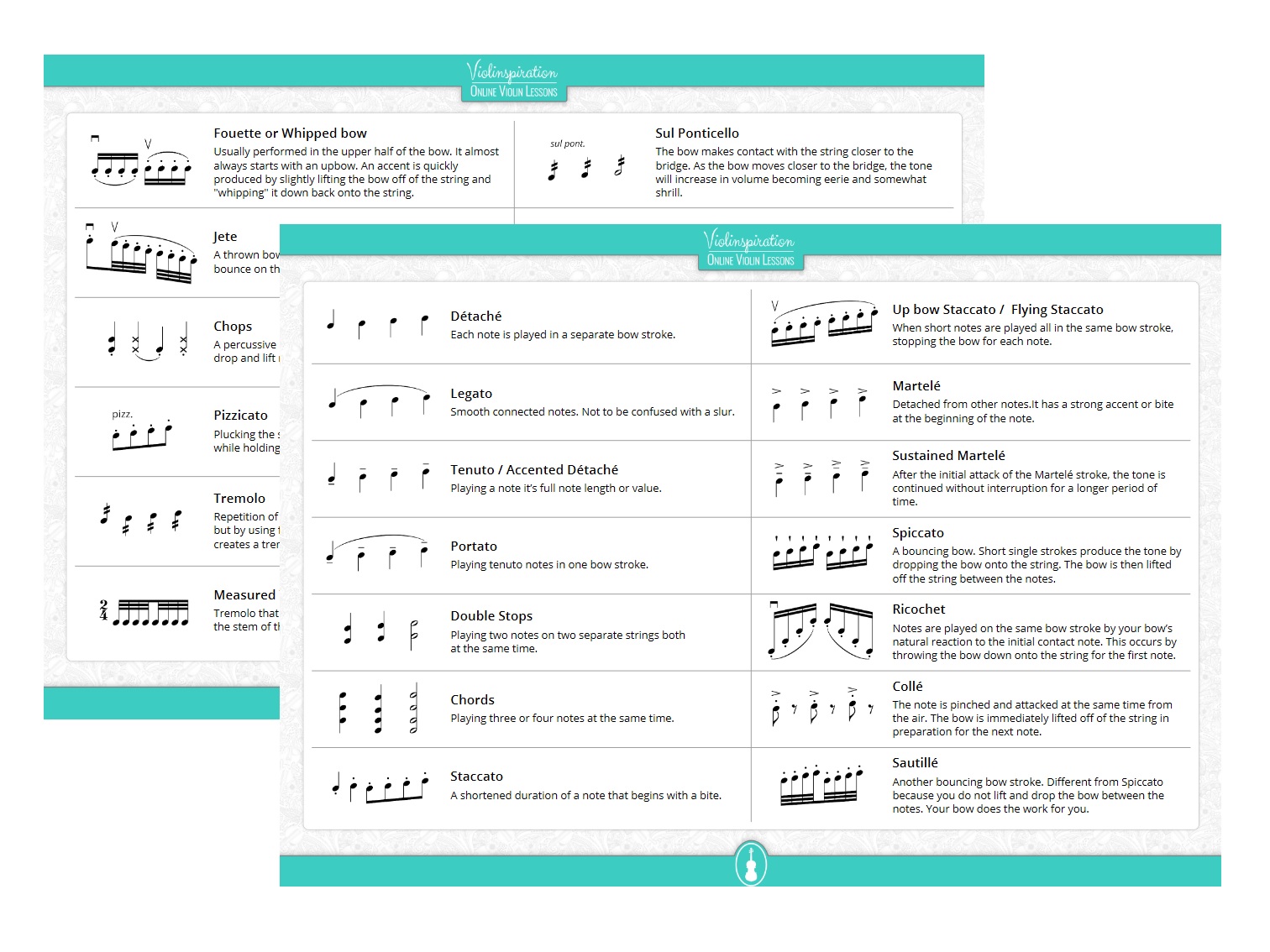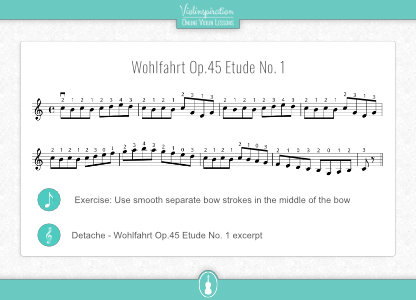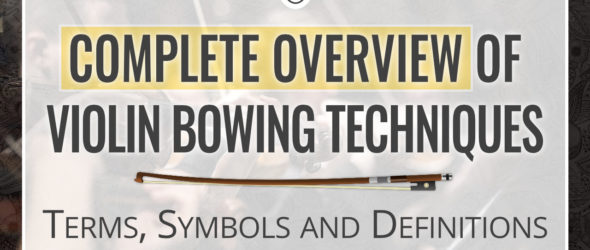In violin playing, there is a wide variety of bowing techniques you can use to make your pieces sound great. Whether you are a professional violinist or want to play for fun, gaining a full understanding of the different types of bowing techniques can be very helpful.
Not only can it help you to get an idea of which bowing techniques you might want to improve, but by learning to recognize the symbols and notation of the bowings in sheet music, you will also quickly understand which bowing techniques the composer would like you to use. That way, when seeing a new piece of sheet music, you will quickly be able to interpret the bowing signs and start playing!
Understanding Bowing Symbols
When looking for guides online, you might realize that understanding bowing symbols and notations can be very confusing. Multiple bowing techniques are often notated with the same bowing signs.
Thus, knowing which bowing technique to use when playing a piece is often left up to the player. The composer, time, style of the piece, and the player’s artistic expression can influence their decision and violin playing.
If you are unsure what bow stroke to use, the best thing you can do is to look up the piece on the internet. For instance, by watching a video of other violinists, you will be able to see which bowing technique they choose to play for that particular piece, helping you decide.
In this article, I will simplify this for you by showing which bowing techniques can be meant with each sign. Additionally, I’ve included video snippets of each bowing technique as an example, so you can see how to play it on your violin, and hear how it sounds.
Notation and Definitions of Violin Bowing Techniques
I have put together a list of the most commonly used bowing technique terms, symbols, and definitions. The list is divided into three categories.
The first is Smooth Bowing. These are bowings you would use as a solo player or playing in a small string ensemble to create smooth and sustained sounds.
The second category is Accented Bowing. Here I have added bowing techniques that you would use to play emphasized short and long notes.
Lastly is Orchestral Violin Bowing Techniques. These bowing techniques/markings are commonly found in violin parts in orchestral compositions to produce more sound effects. Playing in an orchestra requires different bow notations and additional techniques for that of a soloist. It is only right that it should have its category.
Smooth Bowing
Smooth and sustained sounds

Détaché bow stroke
On violin and other string instruments, détaché is a playing technique that uses long, separate, up, and down bow strokes for each note.
In sheet music, the notes have no bow marking. Therefore, if you see no slurs or accents, that is an indication to play the section of the score détaché.

Legato bow stroke
Playing notes legato means playing them smoothly and connected. In other words, you’re playing with no interruptions between the notes.
You can play legato in two ways, either by playing multiple notes in one bow stroke or by connecting two separate strokes seamlessly.
The legato marking is an arch, found either above or below several notes connecting them.

Tenuto
The marking for tenuto found in sheet music is a short dash or line, found under or above the note head. When you see this marking, it means to play the note it’s full length or value (as opposed to stopping a little earlier, like when you are playing staccato)

Portato
Portato is playing several tenuto notes in one continuous bow stroke, thereupon creating a strong regular rhythm that rises up and down as you bow. The sound is similar to a pulsation compared to the separated notes of tenuto.
It is marked in music by a line above or below the note head, with an arch connecting the notes that you are to play.

Double Stops**
This is described as playing two notes on two separate strings both at the same time. This can be done by stopping two separate strings, or stopping one string and playing the string open (not stopped).
In sheet music a double stop is indicated by two notes, one on top of the other.

Chords**
Playing three or four notes so they sound as if they are being played at the same time. Because the curvature of the violin bridge makes it impossible to play three strings at the same time, you play chords as a quick succession of double stops.
Triple stops or quadruple stops are other names for chords.
Three or more notes stacked in sheet music is how you can tell you are supposed to play them as chords on your violin.
** Can also be played with an accent.
Accented Bowing
Emphasized short and long notes

Staccato bow stroke
Staccato bowing is shortening the duration of a note length and beginning with a bite. To rephrase it, beginning with a bite similar to martelé, you play about half as long as the original note value.
This technique is indicated in the music with a dot over or below the note head.

Up-bow & Down-bow Staccato
Multiple short and detached notes that start with a bite or accents and are all played in one bow direction are called up-bow or down-bow staccato.

Martelé bow stroke
Detached from other notes, the martelé bow stroke has a strong accent or bite at the beginning of the note. You can do this by adding a bit of pressure with your index finger. This is done by adding pressure to the bow so it presses down on the string before you start to bow. You begin the note by releasing the pressure and with rapid bow speed, reducing the bow speed near the end.
It is marked in music by a line or accent over the note.

Sustained Martelé bow stroke
After the initial attack of the martelé stroke, the sound of the sustained martelé is continued (sustained) without interruption for a longer period.

Spiccato bow stroke
Spiccato is a bouncing bow technique. Short single strokes produce the sound by dropping the middle of the bow onto the string of the violin. You lift the bow of the string between bow bounces. Spiccato is more often used in faster passages than that of staccato, requiring trained technique and good bow control.

Flying Staccato
The flying staccato stroke is often combined with a regular, upbow staccato stroke. The first notes of the run are played with regular staccato and the closer to the frog the violinist gets, the notes slowly change into a spiccato-like stroke.

Flying Spiccato
Flying spiccato is when you play many spiccato notes in one bow direction – usually on an upbow – but the bow keeps the same contact point for each stroke.

Ricochet bowing technique
When playing this technique, notes are played on the same bow stroke by your bow’s natural reaction to the initial contact note. This natural reaction occurs by throwing the middle of the bow down onto the string for the first note, thus the bow will bounce or ricochet.

Collé bowing technique
To play collé on the violin, the note is pinched and the strings are attacked at the same time from the air. The bow is immediately lifted off of the string in preparation for the next note.
A flexible wrist, relaxed arm, and fingers will help this movement feel more natural.

Sautillé bowing technique
Sautillé is a quick bouncing bow stroke. Different from spiccato because you do not lift and drop the bow between the bow bounces. When playing sautillé, you move the bow so quickly that it has a natural up and down bounce. The bounce will be better if the middle of the bow makes contact with the string.

Fouette or Whipped bowing technique
An accent is quickly produced by slightly lifting the bow off of the strings of the violin and “whipping” it down back onto the strings. This requires speed and arms control.
This technique is usually performed in the upper half of the bow. It almost always starts with an upbow.

Jete bowing technique
A thrown bow that you control with your arm, wrist, and fingers. Therefore, you control the bounce, speed, and quality of sound you can produce.

Chops bowing technique
Chops is a percussive bow technique, executed with a vertical drop and lift motion of the bow onto the strings. You control the bounce with your arm wrist and fingers.
Your sound will be more solid if the contact is made with the strings near the bow’s balance point. This is located in the lower half of the bow near the frog.

Pizzicato
Pizzicato is a percussion technique used for string instruments. Violinists pluck the strings of their violin with their finger instead of using bow strokes.
You can use either the finger of your left hand or right, usually while holding the bow.

Marcato
A notation in music indicating to bow note, passage, chord, etc. with more force. The player accentuates them more strongly than the other notes in the passage.
Orchestral Bowing Techniques

Tremolo bowing technique
Tremolo comes from the word to tremble. The technique requires the repetition of a note where the player plays as fast as possible, without using any specific rhythm. Doing this creates a trembling sound that adds great effect if the composer or conductor wants to add tension or heaviness to a section of the score.

Measured Tremolo bowing technique
Tremolo that needs to be played into a precise rhythm. The rhythm is noted using a specific number of flags in the stem of the note.

Sul Ponticello
A notation in the music indicates to the violinist that the bow makes contact with the string away from the fingerboard and closer to the bridge of the violin. As the bow moves closer to the bridge, the tone will increase in volume becoming eerie and somewhat shrill.

Sul Tasto
Sul tasto is a bowing instruction in the music for the violinist to bow over the fingerboard creating an airy, flute-like effect and warmer sound.

Col Legno
Col legno is a term used to describe a bow technique where the sound is produced by hitting the wood of the bow onto the string, as compared to drawing the hair of the bow across it.

Au Talon
Talon is French for “the heel” and the term au talon, “at the heel”, means to play the music with the bow hair at the heel or bottom part of the bow closest to the hand. Other terms for playing music using the bottom part of the bow include “at the frog” or “at the nut”.

Arco
Acro simply means to play your violin with the bow. The sign is most commonly used to let you know to switch and use the bow after playing pizzicato with your finger.
Violin Bowing Techniques PDF Chart (with Terms, Notation, and Definitions)

Download Free Bowing Cheat Sheet!
an easy overview of all bowings and signs
3 Exercises for Bowing Techniques
The basis of great bowing technique is a good violin bow hold, bow pressure, and making sure one bows in the middle between the bridge and fingerboard of the violin. After that, many pieces of repertoire sound beautiful with only détaché and legato bowing. If you know how to use these two techniques and create a beautiful tone, you will be playing many violin pieces beautifully.
Below I have included three exercises you can do to improve these techniques. You can download them and practice your détaché, legato, and martelé. Two of the practice exercises are from Wohlfahrt – Op. 45, and one is an excerpt from Mazas Op.36.

Download 3 Easy Bowing Exercises
Final Note
As can be seen in this article, there are many violin bowing techniques and symbols for a violinist to learn. Mastering all of them will take a lot of hard work and practice. With diligence and much patience, it can be done.
If you want to further advance your playing to play some of the violin masterworks, eventually you will need to learn every single one of them!
Start with one type of bowing using the middle of the bow, e. g. détaché. Next, add legato. If you are solid in your foundation of the basics, try collé. The more you practice, the more natural your violin will feel when you play.
When you’re at the point where you feel comfortable with the basics of your bowings, add something more advanced.
Watching a video can help. In a video you can not only hear how to play technique, but you can also see it. For example, you can see how close to the fingerboard a violinist plays when playing sul tasto, or how high they lift their bow off the string when playing fouette.
The secret is to take it one step at a time. Enjoy the process, knowing that this is a journey, not a sprint, and most importantly, have fun!
























